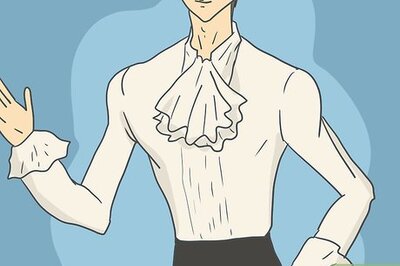
views
X
Research source
People in the Silent Generation are now elderly, and they lived through many historical events in their youth, such as World War II, and the Vietnam War in their young adulthood. Here are some ways to identify if you are part of the Silent Generation.
Checking Through Facts
Know your birth year. Members of the Silent Generation were born from the years 1928 to 1945, the last year of World War II. If you were born between these years, you are part of the Silent Generation. So, if you were a minor during World War II (1939-1945), then you are part of the Silent Generation. If you were old enough to serve in the military during the war, you are part of the Greatest Generation. If you were born after the war, you are likely a Baby Boomer or a member of a more recent generation.
Check when you retired. The average age of retirement is between the late 50s and late 60s, with the US averaging 65 years of age. Therefore, if you retired between 1986 and 2012, you are probably a member of the Silent Generation.
Checking Through Historical Events
Think about how many countries' leaders you remember hearing about. If you heard names such as Franklin D. Roosevelt, Joseph Stalin, Adolf Hitler, and Chiang Kai-shek mentioned in the news, then you are probably a member of the Silent Generation. These historical figures played significant roles in World War II, a period the Silents lived through in their youth.
See if you have a few memories of World War II. Silents were minors (0-17 years old) during the Second World War. If you remember news broadcasts talking about the war, or if you hid in bomb shelters/were evacuated during the war, then you are likely a member of the Silent Generation, as long as you are in the correct age group. Additionally, if you had an older sibling or a parent that served in the war, you may be a Silent. Your hometown may have been bombed. You may also remember relatives dying in combat. For example, kids in the UK took refuge in bomb shelters, drew blackout curtains over windows, and were evacuated from large cities to small towns in the countryside, which was less bombed. If you experienced food shortages during your childhood because of the war, you may be a member of the Silent Generation. Food and other materials were rationed heavily during the Second World War to provide enough resources for soldiers. To make the most of what they had, people grew their own vegetables, and made or mended their own clothing.
Determine if you were part of Japanese internment, in which 112,000 people of Japanese descent were forcibly relocated and incarcerated into ten internment camps. Japan's bombing of Pearl Harbor caused the US to fear and distrust Japanese people. In February 1942, President Franklin D. Roosevelt signed Executive Order 9066. This was a document that caused Japanese-Americans to be forcibly relocated from their homes into internment camps. These camps were very crowded and had poor sanitation, meaning diseases spread quickly. You may have faced discrimination if you were a Japanese-American in the 1940s and 1950s.
Determine if you experienced traumatic events related to the war. World War II saw the unfolding of many violent events, such as the Holocaust, and the bombings of Hiroshima and Nagasaki. If you have painful or traumatic memories associated with these events, you are likely a member of the Silent Generation. 60 to 70 million people died during World War II due to starvation, disease, dying in combat, and mass-bombings. These events may well have affected and irreversibly changed the course of your early years.
Checking Through Shared Experiences
Remember the radio era. People commonly used the radio throughout the 1930s, 40s and 50s. This was a time before television dominated as the main source of entertainment and news. News broadcasts would be audio-only. . There were many popular shows broadcast via radio throughout these decades. If you remember using the radio in your daily life, you are probably a member of the Silent Generation.
Think about food shortages. During the Great Depression (1929-1941), millions of people across the world struggled to earn a living. Many people lost their jobs during the Depression, and many families had to live on meager food and water. Families had to save up most of their money for necessary items (food and water), so anything beyond bare necessities (such as entertainment) were eliminated. If financial strain related to the Depression loomed over your early years, you may well be a member of the Silent Generation. Think about if you lived on hand-sewn clothing or if you grew your own food. Did your parents teach you to be frugal, saving up money for needs and not wants? If you played board games such as Monopoly at home to distract yourself from the turbulent Depression, you may be a Silent. Soap operas and radio shows were popular sources of entertainment. Think about popular shows you watched as a child to confirm that you are a member of the Silent Generation. The timing and severity of the Great Depression varied significantly across countries. It was particularly long-lasting and severe in the United States and Europe, but much milder in Japan and the majority of Latin America.
Remember significant historical events that dominated the news. Think about which events you remember happening or hearing about in your early years. The Silent Generation grew up in a time of global upheaval and change. These were more than just news stories to many: they were events that would shape the course of history. You may have seen these in newsreels or heard of important events from radio broadcasts. Maybe these broadcasts made distant events feel real and stick in your memory, or maybe some even touched you personally. Some events that members of the Silent Generation have lived through include: Alexander Fleming's discovery of penicillin in 1928 Amelia Earhart's solo flight across the Atlantic in 1932 The Great Depression (1929-1941) The Holodomor/Ukrainian Famine of 1932-1933 The Spanish Civil War (1936-1939) The abdication of Britain's Edward VIII and the subsequent crowning of his brother, George VI in 1937 World War II (1939-1945)
Think about popular movies you saw or heard about. If you saw movie posters for these iconic movies, or if you saw these movies in theaters at the time, you might be a member of the Silent Generation. American movies from before 1935 were pre-Code, meaning that they didn't follow a strict set of rules regarding morality, which made them more risqué and daring. Later, the Hays Code was introduced, banning excessive romance, nudity, profanity, and other elements considered inappropriate. There were many iconic movies of the 1930s-1950s, with popular actors and actresses starring in them. These included: All Quiet on the Western Front (pre-Code, 1930) Frankenstein (pre-Code, 1931) King Kong (pre-Code, 1933) Snow White and the Seven Dwarfs (1937) Gone with the Wind (1939) Casablanca (1942) For Whom the Bell Tolls (1943) It's a Wonderful Life (1946) The Three Musketeers (1948)
List how many popular songs from the 1930s-1950s you know. If you listened to music during the 1940s-1950s, you probably know many famous musicians and songs. The 1930s was notorious for its swing music, deriving from the jazz of the 1920s. Scat singing was also popularized. In the 1940s, patriotic tunes helped the US's war effort in World War II. Jazz was also a dominant genre in the 1940s. By the 1950s, the rock-and-roll genre had taken over, meaning edgier music gained in popularity. Some songs you may have heard as a member of the Silent Generation include: Pennies From Heaven (1936), Bing Crosby Sing, Sing Sing (With a Swing) (1937), Benny Goodman God Bless America (1938), Kate Smith's cover I'll Never Smile Again (1940), Tommy Dorsey and His Orchestra with Frank Sinatra and the Pied Pipers Boogie Woogie Bugle Boy (1941), The Andrews Sisters Take Me Back to Tulsa (1941), Bob Wills and His Texas Playboys This Land Is Your Land (1945), Woody Guthrie Buttons and Bows (1948), Dinah Shore Goodnight, Irene (1950), The Weavers (cover) Because of You (1951), Tony Bennett (cover) That's Amore (1953), Dean Martin
List celebrities or famous figures of the 1930s-1950s you remember. You may have heard about these people in the news, seen them starring in movies, or listened to their songs. Even though people suffered through hardships and difficult times, they still managed to enjoy their lives by listening to the radio and playing games. If you were young in 1930s-1950s America, you may have heard of most of these people. This includes: Actors: Henry Fonda, Clark Gable, Greta Garbo, Jean Harlow , Ingrid Bergman, Humphrey Bogart, James Dean, Judy Garland , Lucille Ball, Marlon Brando, Marilyn Monroe, Elizabeth Taylor Musicians: Louis Armstrong, Tommy Dorsey, Ella Fitzgerald, Billie Holiday, Gene Autry, Glenn Miller Orchestra, Frank Sinatra, The Andrews Sisters, Chuck Berry, Fats Domino, Brenda Lee, Elvis Presley



















Comments
0 comment